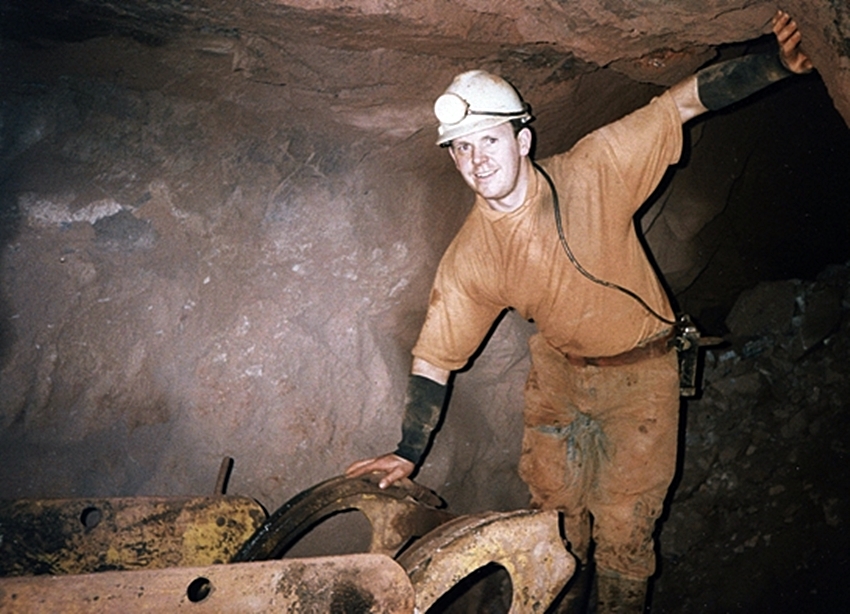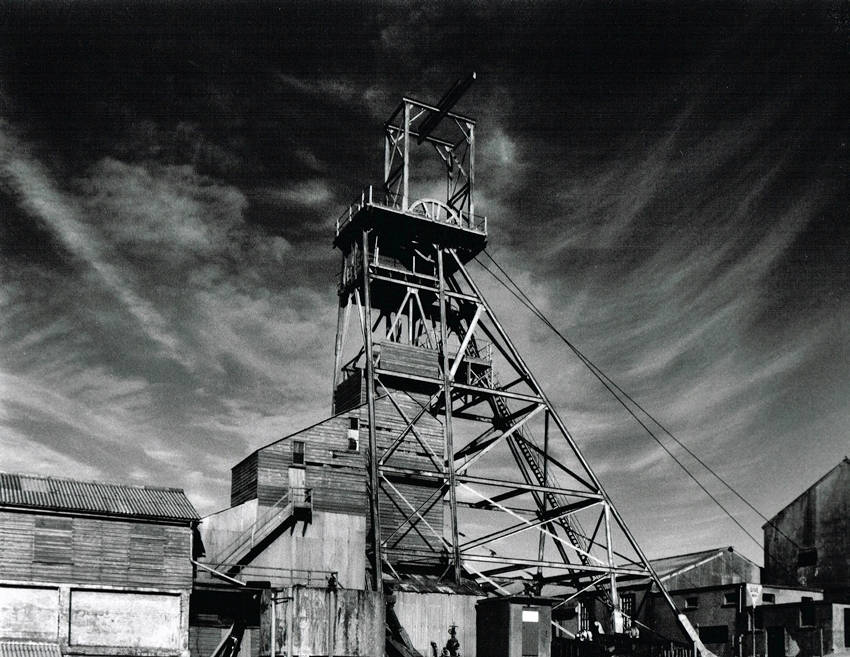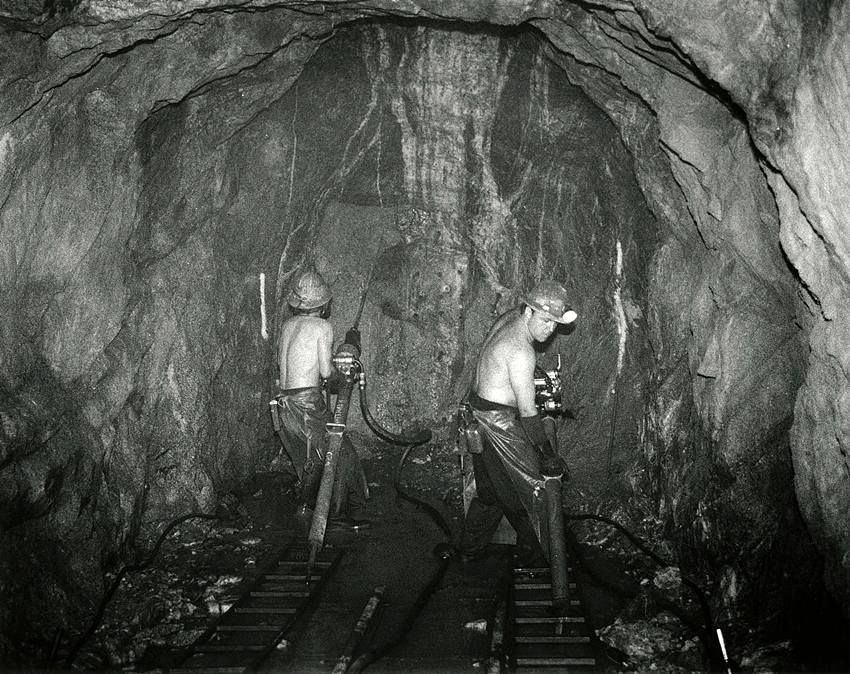Cornish Miners Memories 5: This is an account from Gary Parrott who worked at Geevor Mine in its final years.

My short but colourful time as a Miner at Geevor. By Gary Parrott.
I started at Geevor in 1988 August I think and attended my interview with one other. We were taken underground for a tour and given the job as underground labourers. I turned up to an alien environment on the Monday. The guy who was meant to be starting with me had not turned up.
I had left a position of herdsman on a 150 cow herd due to good old Maggie introducing milk quotas and killing the industry over night. The owner could not keep me on salary, I could not work for agriculture rates. So I took the plunge into mining. Cornish Miners Memories 5
Well my first week at Geevor started as a timberman. God I found this boring and though what the hell I was doing working in a mine. I was at Victory Shaft station on 1500 level waiting to go up to the surface when Brian Nicholas known as ‘Nic’ said I am looking for a crewman to work the incline Grizzly’s with me.
Two or three of the older miners chuckled but I though this has got to be better than timbering. The following morning I heard the Shift boss call me, “Nic said you fancy having ago at the Grizzly’s” That was it off down the shaft to meet up with Nic and to learn the ropes. Prior to starting Nic took me to meet “AJ” who ran the 1500 level Grizzly, it looked damn scary.
Anyhow, the role of the subincline Geevor Grizzly man was as follows.
Take the men up and down the incline to and from there place of work. Transport materials and explosives to the incline levels. Keep 1600, 1700 and 1800 levels grizzly’s clear. Run the ore shoots onto the conveyor 1600, 1700, 1800 and 1900 into the skip shaft.
After learning all the bell calls for the incline buggy, I was away and soon became skilled at moving locos up and down levels. Keeping the Grizzly’s clear though was a battle, the two of us worked together to start with. Once Nic knew I was safe we would just meet up when a grizzly needed two of us. Using 15lb big hit or sledge hammer to smash the rocks on the grizzly soon boosted your muscles. Cornish Miners Memories 5
The bigger rocks were a nightmare though and as I did not have a blasting ticket I would try and beat the living daylights out of some of the granite, Nic would arrive place a couple of sticks of gelamex ‘explosive on them and we would set the siren on head back to the shaft station and Boom. Give it ten minutes go back and they had pretty well gone, or easy to finish off with the sledge.Cornish Miners Memories 5

Towards the end of our shift we would take turns to run the ore chutes under the grizzlys onto the conveyor to the skip shaft taking care not to overload the belts. These flowed pretty well most of the time. But the occasional use of a bar was required to persuade the chutes to run.
When these were empty we would pick the men up on the incline at the end of their shifts to Victory Shaft 1500 level where they would go up in groups of nines to the surface. After 3 months I obtained my secondary shot firers certificate and could blast the rock on my own. This was awesome, I felt I have the power and blasted loads.
Just prior to getting my certificate Willie Treglown my shift boss said you are strong enough and fit enough to go stopeing, would you be interested. I did not hesitate as it was like a Wonka Golden Ticket. Not many got the chance and even though I felt I would be leap froging the cue I was not going to turn it down.
My chance soon came and I was put on a two month test period with Errol Boase and Les Thorne on 18 Treglowns lode. I could soon tell that the grizzly had been the best grounding for this new role as the equipment, and the environment was hostile to say the least.
First couple of days I spent assisting Errol and having a go at drilling then it was time. Errol helped me setup and I was off on my own drilling over two benches in the stope. Errol said to make good money I needed to drill between 18 and 21 eight foot holes, all parallel and perpendicular to each other. The granite was very hard here and 18 inches was the maximum burden required to break the ground and not leave any sockets.
Well I was determined to succeed and I can remember I actually managed 15 holes on my first attempt. Errol was pleased and said he thought I would only get 8 or 10 holes drilled. But that night it felt like I had run a marathon. After the 2 months were up I had made the grade and was made a full equal partner on 18 Treglowns. Complete with my primary shot firing certificate that allowed me to blast.
After another 2 months Errol came to me and said Gary I’m getting too old for this boy, would you like to take the stope over and run it, again I said yes and could not believe my luck. Willie was also delighted I had accepted as he thought I may decline due to lack of experience.
So as Les Thorne was stoping elsewhere in the mine I had to choose a new stopeing mate. I was lucky to get Vitek Urbanski who was a very experienced developer/tunneller as my crew mate and equal. With my trammers Jonney Bryz and Brian Hopkins we made a successful team until the sad closure on February 16th 1990.
Thanks Gary for permission to publish this on Cornish Miners Memories 5.

Paul (Winja) has kindly put together a few words about Diamond Drilling using the VAG Drill Rig for Cornish Miners Memories 5:
The Boyles VAG Diamond Drill, this drill was used to drill 46mm wide holes. In order to gather core samples so the Mine Geologists could establish where the Tin was. Also what values they could expect to get when the area was mined.
The drill motor contains plastic veins that are turned by forcing compressed air into them at around 100psi. The motor is lubricated with rock drill oil, these drills are rated to drill up to 290m holes. The core samples are collected in a 3m long barrel where they are then sent to the assay lab for testing for tin content.
These machines are extremely noisy. The volume is not too dissimilar to that of jet engine at take off. It wasn’t uncommon to find that your teeth would chatter together when running at full power.
On one occasion the water swivel bearing seized up and my hand was caught in the armoured water hose. I was pulled off the ground and only just managed to free myself. My glove remained caught in the hose, the drill ripped the top off the water pump and hurled it around the site at frightening speed. I was lucky to escape with just a broken bone.
Thence forth the VAG became affectionately known as The Widow Maker.
Winja
Diamond Driller
South Crofty Mine 1985-1998

Neil Hodges has kindly written a piece for the Cornish Miners Memories 5. In his own words, his Miners Memories:
I spent some time on several different mining disciplines while underground at South Crofty. But track development headings was where most time was spent. My workmate at the time was ex Geevor miner Brian Whittaker. We would start our shift at 6am. An hour before the main day shift started, to get better air pressure as all equipment ran on air. Also when the mine was in full swing during the day pressure could drop considerably, slowing production.
The first task of the shift would be to walk into the end with a pinch bar looking for any loose ground overhead. We would tap the back (the roof of the drive) with the bar as we walked into the end and listened for any hollow sound. This would indicate loose rock and would be barred down before walking on.
On reaching the muck pile from the previous days blast. We would wash the whole area down with water to damp the dust and dissolve any blast fumes in the dirt. Standing on the muck pile we would continue to examine and bar down the back, face and sidewalls of the end. Next we would muck out the end.
This was normally done with an Atlas Copco LM56 air shovel which had a bucket on a rocker mechanism. The mucker was driven into the pile, filling the bucket. On the way back to the waiting empty wagon the bucket was pulled back overhead on a chain to empty into the wagon behind. Once the wagon was full it was either put into a shunt (a short spur of track) to join other full wagons. Or taken straight to the tip if it was nearby.
As mucking progressed the track would come to an end. To advance the track temporarily into the muckpile a “dropset” and “slider” were used. A dropset was a 3m length of parallel track welded together and a slider was a 3m length of track welded in such a way that the rails were turned on their side. The slider would fit inside the guage of the main track and slid into the muckpile by pushing it with the bucket of the mucker.
As the pile was mucked away the slider would be advanced as necessary until it was at its full extent. It would then be lifted out and replaced by the dropset which was bolted to the existing main track. The slider was then dropped inside the dropset and advanced into the muckpile as before. When the end was mucked out permanent track was laid if necessary along with services. These consisted of 4inch air pipe and 2inch water pipe sat on steel “L” pegs installed in the sidewall.
The next job was to drill the round in the face of the heading. This was done with both miners using pneumatic rock drills with an air leg attachment. At the time I was there we used SIG 24k or 29k machines. But prior to this Holman Silver 303 machines were used.
We would collar each others holes on the face before drilling to full depth. Typically 6 or 8 feet, a set pattern of holes consisting of the cut at the centre. Then radiating out from that would be a series of holes in either a box or diamond configuration until the sides of the heading were reached where profile holes were drilled.
The top profile holes were known as back holes and the ones on the floor were known as lifters. There were typically 36 holes in a regular round. This would take between an hour and a half to two hours to drill. This depended on the length of holes and the ground conditions.
Once drilled the holes were blown clean with compressed air before being charged with explosive. The charging process was crucial in that the timing of each blast hole going off determined whether a clean blast would occur. The holes were primed with a stick of dynamite containing the detonator, then further filled to the end with ANFO. This was a powdered explosive blown into the hole using a “Penberthy” anfo loader. The “dets” were numbered from zero to about 24. Each number up meant a delay of half a second.
Zero would be used in the cut as this was the first part of the face to be blasted. Then at half second intervals the other holes would go off in a radiating pattern with the profile holes going off last. The dets would then be wired together into a circuit of wire ready for blasting. This was obviously done from a safe distance away from the face by means of a small device known as a “Bethoven”.
This was basically a hand cranked dynamo which you would wind to generate enough charge to send down the wires to set off the blast. There was always relief at hearing, and feeling, the blast going off. Knowing you didn’t have to return to the face to sort out any problems (usually a broken wire somewhere). Basically that’s all there was to it !!
Time to head back to the shaft for the cage ride to surface. This was a chance to catch up with the other miners and have a bit of a laugh and joke. One common prank was played out during the journey back to surface. The cage at Crofty was a double decker. During the ride up, the miners on the top deck would empty their water bottles down onto the guys below for a laugh.
However, the bottom deck was always emptied first when the cage got to surface. Then soaked miners would get the water hose kept nearby and give the top deck a darn good drenching as payback. This was all taken in good spirits and sums up the camaraderie between the miners.
